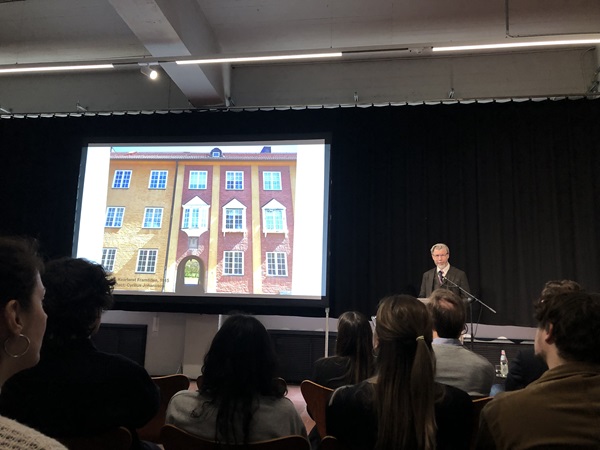 Credit: Otilia Dragan/Chronicle.lu
Credit: Otilia Dragan/Chronicle.lu
On Friday 19 April 2024, April Initiative hosted its first lecture at the Luxembourg Center for Architecture (luca) in Luxembourg-Clausen.
The April Initiative is a non-profit think tank that aims to promote cross-disciplinary dialogue among professionals shaping the future of the built environment. Its current reported theme is that of alternative forms of housing.
The evening’s speech was held by Swedish author, urban designer and artist Jan Rydén Bonmot, aiming to offer insights into today’s housing affordability crisis by examining how comparable challenges were tackled in Sweden more than a century ago. Jan Rydén Bonmot noted that nowadays, discussions about style and classicism tend to be rooted in right-wing conservative ideology. In this lecture, based on his book A Humanist Classicism, he emphasised that classicism could have humanist values with a socialist core, as it did in the case of Sweden between 1920 and 1930.
Sweden in 1915 was a “poor” country and among Europe’s most unequal countries in terms of the differences in wealth between its wealthiest and its most vulnerable citizens. According to Jan Rydén Bonmot, a difference in policy was able to help restore the country’s economy. In a situation starkly similar to that of Luxembourg, the country had just experienced the aftershocks of war (World War I), the Spanish flu pandemic, followed by inflation and a speculative housing development. In an era of crisis, the market-driven real estate development then stopped dead in its tracks, and commercial building activity stopped.
There was “very little ownership” of housing in general. Rental apartments were available, but they put citizens at the mercy of landlords. A window of opportunity opened for cooperatives. A progressive think tank of liberals and socialists made this change: cooperatives had existed for 40-50 years but they would often build one house and stop there; now the challenge was to “scale” that solution. A tenant’s savings bank and building association was started made up of savings bank, mother association sharing in the development and knowledge and daughter associations which owned local housing. In a surprisingly brief timeframe, affordable housing with high aesthetic standards was constructed.
People in this form of housing did not fully own their space but had the “right to live” in it. Because a vast number of people were interested in getting a better home, it made them put their money in the savings bank of this non-profit (or low-profit) organisation, which helped fight the “greedy landlords” and combat speculation in Stockholm, Jan Rydén Bonmot explained. The aim was to live in an idyllic home even in the city: architects started designing plots into a version of an architectural welfare state. Between 1923 and 1927, the city saw the rise of over 2,500 workers' flats that featured advanced living standards, including amenities such as in-house bathrooms that were revolutionary at the time, special rooms for children, and later also cooperative stores. In 1925, they went from individual houses to district ideas. Building massively in this way meant the prices could go down.
According to Jan Rydén Bonmot, what made this successful was the fact that the city had made a plan of available building plots and the state guaranteed loans to building cooperatives. The last 10% of the flats’ costs had to be covered by the tenant or buyer themselves.
Despite being large-scale, low-cost efforts, these buildings prioritised a sense of Nordic classicist, colourful aesthetic and put the focus on creating carefully decorated façades with textured walls, classical ornamentation and more. Their green courtyards were another important element, one of their qualities inspired by the garden city movement. Often they would include playground areas for children.
April Initiative noted that this pioneering movement could perhaps help inspire solutions to today's housing dilemmas in Luxembourg.









